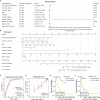A Nomogram Combining a Four-Gene Biomarker and Clinical Factors for Predicting Survival of Melanoma
- PMID: 33868993
- PMCID: PMC8047639
- DOI: 10.3389/fonc.2021.593587
A Nomogram Combining a Four-Gene Biomarker and Clinical Factors for Predicting Survival of Melanoma
Abstract
Background: Currently there is no effective prognostic indicator for melanoma, the deadliest skin cancer. Thus, we aimed to develop and validate a nomogram predictive model for predicting survival of melanoma.
Methods: Four hundred forty-nine melanoma cases with RNA sequencing (RNA-seq) data from TCGA were randomly divided into the training set I (n = 224) and validation set I (n = 225), 210 melanoma cases with RNA-seq data from Lund cohort of Lund University (available in GSE65904) were used as an external test set. The prognostic gene biomarker was developed and validated based on the above three sets. The developed gene biomarker combined with clinical characteristics was used as variables to develop and validate a nomogram predictive model based on 379 patients with complete clinical data from TCGA (Among 470 cases, 91 cases with missing clinical data were excluded from the study), which were randomly divided into the training set II (n = 189) and validation set II (n = 190). Area under the curve (AUC), concordance index (C-index), calibration curve, and Kaplan-Meier estimate were used to assess predictive performance of the nomogram model.
Results: Four genes, i.e., CLEC7A, CLEC10A, HAPLN3, and HCP5 comprise an immune-related prognostic biomarker. The predictive performance of the biomarker was validated using tROC and log-rank test in the training set I (n = 224, 5-year AUC of 0.683), validation set I (n = 225, 5-year AUC of 0.644), and test set I (n = 210, 5-year AUC of 0.645). The biomarker was also significantly associated with improved survival in the training set (P < 0.01), validation set (P < 0.05), and test set (P < 0.001), respectively. In addition, a nomogram combing the four-gene biomarker and six clinical factors for predicting survival in melanoma was developed in the training set II (n = 189), and validated in the validation set II (n = 190), with a concordance index of 0.736 ± 0.041 and an AUC of 0.832 ± 0.071.
Conclusion: We developed and validated a nomogram predictive model combining a four-gene biomarker and six clinical factors for melanoma patients, which could facilitate risk stratification and treatment planning.
Keywords: immune genes; melanoma; microenvironment; nomogram; prognostic biomarker.
Copyright © 2021 Zhang, Dang, Wang and Cong.
Conflict of interest statement
The authors declare that the research was conducted in the absence of any commercial or financial relationships that could be construed as a potential conflict of interest.
Figures





Similar articles
-
Nomogram based on autophagy related genes for predicting the survival in melanoma.BMC Cancer. 2021 Nov 22;21(1):1258. doi: 10.1186/s12885-021-08928-9. BMC Cancer. 2021. PMID: 34809598 Free PMC article.
-
A Novel Nomogram and Risk Classification System Predicting the Cancer-Specific Mortality of Patients with Initially Diagnosed Metastatic Cutaneous Melanoma.Ann Surg Oncol. 2021 Jul;28(7):3490-3500. doi: 10.1245/s10434-020-09341-5. Epub 2020 Nov 15. Ann Surg Oncol. 2021. PMID: 33191484 Clinical Trial.
-
Development and validation of a prognostic nomogram for colorectal cancer after surgery.World J Clin Cases. 2021 Jul 26;9(21):5860-5872. doi: 10.12998/wjcc.v9.i21.5860. World J Clin Cases. 2021. PMID: 34368305 Free PMC article.
-
CXCR3 predicts the prognosis of endometrial adenocarcinoma.BMC Med Genomics. 2023 Feb 7;16(1):20. doi: 10.1186/s12920-023-01451-9. BMC Med Genomics. 2023. PMID: 36750966 Free PMC article.
-
Predicting melanoma risk: theory, practice and future challenges.Melanoma Manag. 2014 Nov;1(2):105-114. doi: 10.2217/mmt.14.15. Epub 2014 Dec 4. Melanoma Manag. 2014. PMID: 30190816 Free PMC article. Review.
Cited by
-
Hsa_circRNA_0040462: a sensor of cells' response to CAP treatment with double-edged roles on breast cancer malignancy.Int J Med Sci. 2022 Mar 21;19(4):640-650. doi: 10.7150/ijms.66940. eCollection 2022. Int J Med Sci. 2022. PMID: 35582416 Free PMC article.
-
Ligand Recognition by the Macrophage Galactose-Type C-Type Lectin: Self or Non-Self?-A Way to Trick the Host's Immune System.Int J Mol Sci. 2023 Dec 3;24(23):17078. doi: 10.3390/ijms242317078. Int J Mol Sci. 2023. PMID: 38069400 Free PMC article. Review.
-
Development and validation of a novel combinational index of liquid biopsy biomarker for longitudinal lung cancer patient management.J Liq Biopsy. 2024 Sep 10;6:100167. doi: 10.1016/j.jlb.2024.100167. eCollection 2024 Dec. J Liq Biopsy. 2024. PMID: 40027304 Free PMC article.
-
Identification of Pyroptosis-Relevant Signature in Tumor Immune Microenvironment and Prognosis in Skin Cutaneous Melanoma Using Network Analysis.Stem Cells Int. 2023 Feb 8;2023:3827999. doi: 10.1155/2023/3827999. eCollection 2023. Stem Cells Int. 2023. PMID: 36818162 Free PMC article.
-
Identification of Molecular Subtypes and Prognostic Characteristics of Adrenocortical Carcinoma Based on Unsupervised Clustering.Int J Mol Sci. 2023 Oct 23;24(20):15465. doi: 10.3390/ijms242015465. Int J Mol Sci. 2023. PMID: 37895143 Free PMC article.
References
-
- Rastrelli M, Tropea S, Rossi CR, Alaibac M. Melanoma: epidemiology, risk factors, pathogenesis, diagnosis and classification. In Vivo (2014) 28:1005–11. - PubMed
LinkOut - more resources
Full Text Sources
Other Literature Sources

